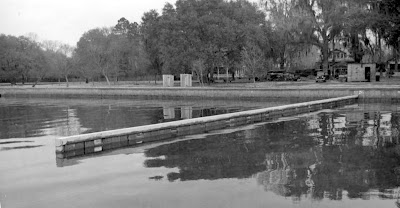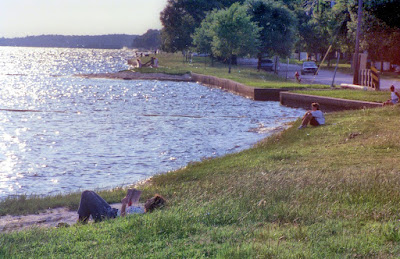Before the seawall, there were sand beaches and driftwood.
In the 1900’s
and 1910’s, they tried to protect the lakefront from erosion with timber
pilings.
But the timber bulkhead didn’t last long. The relentless wave pounding action of Lake Pontchartrain took its toll.
But the timber bulkhead didn’t last long. The relentless wave pounding action of Lake Pontchartrain took its toll.
Public interest continued to mount on building a better seawall. A contract was signed as early as 1913.
Problems arose during construction, however. This newspaper headline is from 1916. This became, as it was called back in the early 20th century, a political issue.
Efforts to build a better barrier continued until 1937 when the WPA, the Works Progress Administration, constructed a concrete seawall and it helped stop beach erosion for a while.
The WPA assigned 150 men to build a better concrete seawall.
Mandeville Harbor
A sturdy well-built concrete seawall
Work done in 1966
Below are more pictures of the seawall falling into the water. In some places they had tried to repair it with bricks, throwing rip rap into the ever widening holes caused by erosion. It was becoming unstable, dangerous, too dangerous to stand on the edge of the seawall to look at the lake.
Here’s a picture of someone in 1973 jumping over a large break in the seawall.
Another seawall renovation project took place in the 1970’s, and 20 years later, another massive seawall building project again took place.
According to an article in the Times Picayune in August of 2017, it’s now time to re-visit rebuilding and repairing the seawall. It’s a never-ending problem because of the never-ending wave action of Lake Pontchartrain reclaiming the lakefront through erosion.
In that article Kim Chatelain said the first seawall was made of wood and was severely damaged by the 1893 hurricane that hit the New Orleans area. “Two years after the hurricane of 1893 destroyed Mandeville's original seawall, which protected only the eastern side of the city, town leaders constructed a new and larger seawall that extended farther to the west,” she wrote. “In 1913, the city decided to build a concrete wall to provide further protection, according to historical accounts.”
She went on to explain that in 1915, before the concrete barrier was completed, another powerful hurricane hit the area, destroying the partially-built wall. The town resumed construction, however, and finished the project.
Ms. Chatelin’s article noted that in the 1930s, the Works Progress Administration public works initiative brought in more than 150 men to build a new seawall that performed admirably for more than five decades. That seawall lasted until Hurricane Andrew decimated it in August of 1992.
In response to that event, U.S. Rep. Bob Livingston “tacked $5.3 million onto a hurricane relief spending bill for the (currently) existing seawall,” the Times Picayune article said.
Because of the continuing erosion, wear and tear caused by the wave action of Lake Pontchartrain, millions of dollars are spent keeping the seawall intact. But what would have happened if the seawall had never been built? What if new seawalls had never been put in to stop the onslaught of erosion?
Above is an aerial photograph from Google Earth that shows the west end of Lakeshore Drive. On the right is the part of Mandeville that has been protected by the seawall. On the left is the natural shoreline of Lake Pontchartrain that hasn't been protected by a seawall.
In this view, one can see the “natural curving shoreline” that makes up the north shore of Lake Pontchartrain. At right is the curving shoreline in front of Fontainebleau State Park, and at left is the continuation of the natural shoreline at Sunset Point Park. What if we were to draw a line following what would appear to be the natural curve without the seawall in place?
Here’s a line that shows us what the natural curve of the shoreline would have been without the concrete seawall protecting it. The lakefront would be gone, Lakeshore Drive would be gone, and half of the first block would be gone. All of that is still there, however, because of the miracle of a concrete seawall.

































